The taxonomy of the genus Citrus is complex, and the precise number of natural species remains unclear. Many named species are clonally propagated hybrids, and genetic evidence suggests that even wild, true-breeding species may have a hybrid origin.
Cultivated Citrus may be derived from as few as four ancestral species. Numerous natural and cultivated hybrids include commercially important fruits such as oranges, grapefruits, lemons, some limes, and some tangerines. This article provides detailed information on the crop Citrus (oranges), including its history, origin, spread into various parts of the world, botany, harvesting, processing, and uses.
Botany of Citrus
Citrus fruits belong to several species within the genus Citrus of the subfamily Aurantiodeae, which is part of the plant family Rutaceae. The Aurantiodeae includes thirty-three mostly subtropical and tropical genera, a few of which hold economic significance.
Citrus fruits are characterized by their distinctive fruit, the hesperidium, a berry with internal fleshy parts divided into segments (typically 10 to 16), surrounded by a separable skin. The name Citrus is derived from classical mythology, referring to the “golden apples” grown in the garden of the Hesperides. When grown naturally, Citrus plants are generally small to large trees with glossy alternate leaves containing oil glands. The attractive and fragrant flowers have an annular disk.
The genus Citrus is divided into two subgenera: Citrus and Papeda. The former contains edible Citrus fruits, while the latter includes papedas, a distinctive group with inedible, bitter-tasting fruits due to high concentrations of acrid oil. The leaves of papedas are also distinctive, with large, prominent petioles compared to those of the subgenus Citrus.
Taxonomy and Hybridization of Citrus
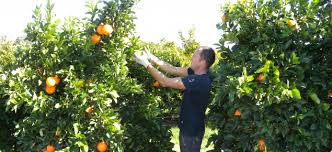
The taxonomy of Citrus remains unclear, as does the taxonomy of the other thirty-two genera in the subfamily. Different authorities have recognized anywhere from three to 170 species of Citrus. This wide variation results from factors beyond mere classification. The most commonly used system, developed by W. T. Swingle or modified versions, recognizes around sixteen species.
Most of the challenges in Citrus taxonomy arise from the free hybridization between different varieties and even species of Citrus. Many types of Citrus originated from such hybridization events in the past. A strict interpretation of the species concept would result in fewer types being awarded species rank, while a looser interpretation would lead to a higher number of species. Controlled hybridizations and selections made by humans to produce more desirable fruits further compound this issue.
The generally accepted concept today is that there are four primordial or fundamental Citrus species: Citrus medica (citron), Citrus grandis (pummelo), Citrus aurantifolia (lime), and Citrus reticulata (mandarin). All other types of Citrus arose from single or sequential hybridization events between these species or their offspring. This concept is supported by classical taxonomy, chemotaxonomy, and molecular analysis.
Citrus Species and Their Agricultural Importance
1. Citrus medica (Citron)
Citron is believed to be native to India and spread prehistorically through cultivation to the Near East and China. By 300 BC, it was known in Greece, and by 20 BC, it was cultivated in Italy. The fruit is yellow, ovoid-oblong, and can grow up to 30 cm long. It has a very thick rind and sour, juicy segments. The rind is used to make candied confectionery, but citron is primarily used for medicinal and ritual purposes. It also serves as a scent. Citron plays a significant role in Buddhist ceremonies and has been part of the Jewish Feast of the Tabernacles since about 100 BC.
2. Citrus grandis (Pummelo, Pamplemousse, Shaddock)
Pummelo is thought to have originated in Southeast Asia. Varieties differ in fruit sweetness, size, shape, color, seediness, and essential oils. By 300 BC, Citrus grandis was grown commercially in China, where it holds importance in Chinese medicine. Before 1200 AD, cultivation spread westward to India, North Africa, and Spain. Although not grown commercially today, it remains popular as a garden tree.
3. Citrus reticulata (Mandarin, Satsuma, Tangerine)
The Mandarin was likely domesticated in tropical Southeast Asia. By 500 BC, it was known in China, and by 300 BC, it was grown commercially in central China. By 400 AD, grafting methods were used to clone favorable varieties, with tree-nesting Taylor ants (Oecophylla smaragdina) defending the trees. Mandarin remains the most important citrus species in China. It was introduced to Japan early on, where the Satsuma variety was developed. Though popular in Asia, Citrus reticulata was only established in Europe, North Africa, the West Indies, the Americas, and Australia in the 1800s.
4. Citrus aurantifolia (Lime)
Lime originates from tropical Southeast Asia, where wild varieties can still be found. Cultivars are developed based on sweetness, size, shape, and color. Lime fruits are used for preserves, garnishes, and juices, and citral oil is extracted for perfumes.
This article highlights the importance of these Citrus varieties in agricultural practices and their contributions to various cultural and economic activities across the world.
Read Also: 12 Medicinal Health Benefits Of Renealmia alpinia (Pink cone ginger)
Propagation of Citrus Trees
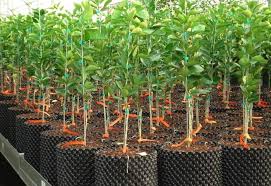
Citrus seedlings have the potential to produce fruit that is identical to the parent tree due to nucellar embryony. However, to avoid the long juvenile period typical of seedlings, trees are often budded onto various rootstocks. Budding can be carried out during most of the year when pencil-sized, round budsticks are available and the bark slips on rootstocks. Citrus bud unions are typically placed higher (8-12 inches above the soil line) than many other tree fruits to prevent the scion from making contact with the ground.
Planting Design, Training, and Pruning of Citrus Orchards
1. Planting Design: Citrus orchards are often arranged in rectangular designs, which eventually form tall hedgerows. Spacings vary depending on the type of citrus:
i. Grapefruit and vigorous trees: 20 x 25 feet.
ii. Oranges and tangerines: 15 x 20 feet.
iii. Limes and smaller cultivars: 12-15 x 18-20 feet.
Tree densities per acre are approximately:
i. 100-110 trees for grapefruit.
ii.130-140 trees for sweet orange.
2. Training and Pruning
Citrus trees require minimal training. Young trees may be headed at 30 inches to promote branching and should be stripped of trunk sprouts and suckers for the first two years. De-fruiting young trees for a year or two helps encourage vegetative growth. At maturity, trees are mechanically hedged and topped to form hedges around 12 feet tall and wide. Minimal hand pruning is required.
Nursery Operations for Citrus Trees
While citrus can be grown from seed, there are several disadvantages. Seedlings may not always be true-to-type with the parent tree, as citrus hybridizes easily. Additionally, seedling trees have a longer juvenile period and are more susceptible to unfavorable conditions and diseases. As a result, most citrus trees worldwide are propagated through budding or grafting.
A budded tree consists of two parts:
i. Scion: The fruit-bearing variety.
ii. Rootstock: Provides support and is selected based on compatibility with the scion, resistance to diseases, and adaptation to soil conditions.
Rootstocks are typically grown from seed since they are apomictic (true-to-type). The rootstock reaches the appropriate size for budding (about the diameter of a pencil) 9-12 months after germination. The scion is then budded onto the rootstock, and the young tree is ready for planting about a year later.
Field Operations for Citrus Cultivation
1. Soil Considerations: Citrus trees can grow on various soil types, but well-drained soils are essential. Drainage can be improved by planting on raised beds or ridged rows. Deep ditches can help carry off excess water, and in areas with high water tables, drainage systems may be necessary.
2. Other Considerations:
i. Proximity to fresh water for irrigation during dry years is beneficial.
ii. Land close to urban areas may be too valuable for citrus cultivation due to high land prices.
iii. Access roads should be in place for easy transportation of citrus, regardless of weather conditions.
3. Land Preparation: Land should be leveled with minimal topsoil removal. In areas with high water tables, ridged rows and drainage ditches are necessary. Sod, such as rye, is often planted in row middles to stabilize soil and prevent ruts.
3. Spacing: Planting distances for citrus trees have been well studied, and key considerations include:
i. High-Density Spacing: Trial plantings suggest 22 x 11 feet for Washington navels and 20 x 10 feet for satsumas. Alternate trees within rows should be removed after 15 years to prevent crowding.
ii. Conventional Spacing: For Washington navels, 25 x 20 feet or 22 x 22 feet is recommended. Wider spacings promote earlier fruit coloring and a higher sugar/acid ratio.
3. Timing of Planting: The best time to plant citrus trees in Louisiana is between late February and early April. Summer-planted trees may experience transplant shock, and trees planted in the coldest months require frost protection.
4. Planting Techniques: Citrus trees from the nursery are available in two forms:
i. Bare-rooted trees: These trees require careful handling to prevent root drying, and the tops should be pruned back by 40% to compensate for root loss.
ii. Containerized trees: Trees grown in containers tend to have better survival rates and are less prone to transplant shock.
The planting hole should accommodate the root system, and back-filling should use the same soil removed from the hole. Water should be added during back-filling to settle the soil and remove air pockets around the roots. A soil drench with Ridomil may be considered to prevent root rot caused by Phytophthora species.
Fertility and Fertilization
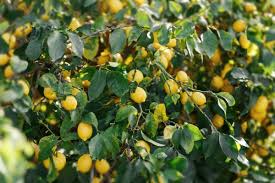
1. Nitrogen: Nitrogen is one of the most critical nutrients in citrus farming as it significantly affects yield. Nitrogen deficiency is evident through uniform chlorosis (yellowing) of leaves, marked by the loss of green coloration. Unlike other nutrient deficiencies, the yellowing in nitrogen deficiency is uniform across the leaf surface and is prominent on fruit-bearing twigs. This deficiency results in smaller fruits with thicker, leathery skins.
Citrus trees, particularly those with high yields, can handle large amounts of nitrogen without suffering adverse effects when balanced with phosphorus and potassium. Nitrogen is especially crucial during flowering, as its levels influence the number of flowers.
During flowering, nitrogen translocates from the leaves to the flowers. When leaves are damaged or weak due to poor nutrition, fruit production can decline. Common nitrogen fertilizers include ammonium sulfate and ammonium nitrate, the latter being preferable as it reduces nitrogen loss associated with the acidity of ammonium sulfate. The amount of nitrogen applied depends on the age and productivity of the trees.
2. Phosphorus: Phosphorus is essential for sustained citrus growth. Phosphate deficiency manifests through small, dull, blue-green leaves. In severe cases, leaves develop bronze-brown discolorations and necrotic spots. Shoot formation is restricted, and the leaves may fall prematurely, sometimes causing twig death.
Phosphate excess is rare in heavy soils, as they can retain high levels of phosphorus. Superphosphate (0-20-0) is the most common fertilizer used for phosphorus supplementation.
3. Potassium: Potassium is typically supplied through complete fertilizers, but potassium chloride (muriate of potash) may also be used. Potassium deficiency initially causes fruits to remain small without external symptoms on the leaves. As the deficiency progresses, the leaves thicken, pucker, and develop necrotic spots. Severe potassium deficiency leads to premature leaf fall and shoot dieback.
3. Trace Elements: Citrus trees often show deficiency symptoms for trace elements, which is why fertilizers should contain them. It is generally advisable to confirm a trace element deficiency through visual symptoms or leaf analysis before treatment.
Young citrus trees on some soils may display trace element deficiencies early on, which should be diagnosed by an expert before applying any corrective measures. Applying trace elements requires special expertise to ensure proper correction of deficiencies.
4. Timing of Fertilizer Application: Fertilizer applications should align with the growth rhythm of citrus trees. Typically, fertilizers are applied in late winter (February) before blossoming and again in summer (June) when summer shoots form. For optimal results, fertilizer should be applied 20 to 40 days before the onset of the first growth in late March or early April.
Irrigation and Soil Moisture Maintenance
Drip or trickle irrigation is an efficient method for maintaining soil moisture in citrus orchards. This system delivers water directly to the plant roots, reducing labor, distribution loss, and evaporative loss. Unlike sprinkler and furrow systems, drip irrigation fully wets only a portion of the soil, significantly lowering water usage. It also enables automation through time clocks or moisture sensors.
A well-designed drip irrigation system includes a carefully planned pipeline, ensuring uniform water pressure across the orchard. The heart of the system is the pump, which carries water through the main pipeline to plant rows.
A filtration system prevents clogs in the lines, and some systems may include a fertilizer injector upstream from the filter. Lateral pipelines placed along each row of trees release water through drip emitters, which typically apply one or two gallons per hour, ensuring that the application rate does not exceed soil percolation and infiltration rates.
While mature citrus trees in some regions, such as Louisiana, may not require frequent irrigation, a critical period is during fruit maturity. Water shortages at this time can lead to fruit splitting and premature shedding. Although the installation of a drip irrigation system can be costly, the increased yields from preventing water stress can offset the expense in just one season.
Read Also: 16 Medicinal Health Benefits Of Scleromitrion diffusum (Spreading Diamond Flower)
Diseases Control and Management in Citrus
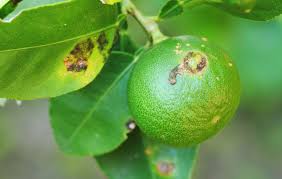
1. Citrus Canker (Xanthomonas axonopodis)
Symptoms: Citrus canker causes unsightly lesions on the leaves, stems, and fruit of the plant. This disease affects tree vitality and leads to early fruit drop. Although the fruit is still safe for consumption, its appearance makes it unmarketable.
Control: To manage the disease, infected orchards are often destroyed to prevent further spread. Copper-based sprays are also used to protect healthy trees.
2. Melanose (Diaporthe citri)
Symptoms: This disease affects leaves, shoots, and fruit, forming dark brown dots or spots. These spots start as sunken but later become raised, giving the surface a rough feel. Fruit infected with melanose is resistant with age but can still suffer from stem-end rot.
Control: Pruning and burning deadwood help eliminate the infection source. Copper sprays can be applied before and after bloom to control melanose.
3. Scab (Sphaceloma fawcettii)
Symptoms: Scab affects satsuma, orange, tangerine, grapefruit, lemon, and sour orange, causing corky, wart-like outgrowths on fruit, leaves, and shoots. Severely scabbed fruit becomes thick and misshapen.
Control: Pruning infected parts and applying copper-based sprays can manage scab.
4. Sooty Mold (Capnodium citri)
Symptoms: Sooty mold grows on the honeydew excretions of white flies, aphids, mealy bugs, and scale insects. It covers leaves and fruit, making them black and reducing sunlight penetration, which affects fruit size and color.
Control: Managing the insect population through pesticides helps prevent the growth of sooty mold.
5. Green Mold and Blue Mold (Penicillium sp.)
Symptoms: These molds infect fruit through skin injuries, causing soft, water-soaked areas that eventually turn powdery green (green mold) or blue (blue mold).
Control: Proper handling of fruit to avoid injuries and using fungicides can reduce mold infection.
6. Sour Rot (Geotrichum citri)
Symptoms: Sour rot causes soft water-soaked lesions on fruit, which emit a strong sour odor. White fungal growth often appears on infected areas.
Control: Prevent fruit injuries and apply post-harvest fungicides to control sour rot.
7. Foot Rot (Phytophora parasitica)
Symptoms: This disease causes water-soaked dark spots on the trunk and can lead to bark cracking and gumming. It is common in areas with poor drainage.
Control: Maintaining proper orchard drainage reduces foot rot incidence. Fungicides may also be applied to manage the disease.
Weeds and Weeds Management in Citrus
- 1. Cultural Control:
i. Exclusion and sanitation practices are vital in minimizing weed introduction and spread.
ii. Practices such as early shading of grove floors by tree canopies and leguminous cover crops help control weed growth.
iii. Proper irrigation and fertilizer application also prevent off-target promotion of weed growth.
- Mechanical Control
i. Cultivation kills annual weeds by severing stems from roots. Repeated cultivation prevents weed competition with trees and brings weed seeds to the surface for germination and control.
ii. However, constant cultivation can harm citrus fibrous roots and spread resistant perennial weeds.
- Chemical Control
i. Herbicides can be foliar or soil-applied, with systemic or contact activity. Soil-applied herbicides are most effective during weed germination and early growth stages.
ii. Systemic herbicides are absorbed through roots or above-ground parts, while contact herbicides damage or kill sprayed parts without translocation.
iii. Timing and frequency of herbicide application are crucial for effective vegetation management, especially in young groves where vegetation is more prevalent.
Harvesting and Postharvest Handling of Citrus
1. Maturity
Citrus fruits are non-climacteric, meaning they ripen gradually over an extended period and do not ripen significantly after being picked. External color changes during ripening, but it is influenced more by climate than actual ripeness, making it an unreliable indicator of maturity. Internal factors such as sugar content (oBrix), acid levels, and the oBrix/acid ratio are the best measures of citrus fruit maturity.
2. Harvesting of Citrus
Citrus is harvested manually, as there is no widely accepted method of mechanical harvesting. The timing of harvest depends on market demands or legal maturity standards.
Citrus fruit can remain on the tree for an extended period after reaching maturity without significant deterioration in quality, although prolonged delays may result in reduced acidity, causing the taste to become insipid. After harvest, citrus fruit can be stored at low temperatures for several months, which has been instrumental in the development of the citrus industry.
After harvesting, citrus fruits are transported to a packing house where they are washed, sorted, treated with fungicides and waxes, and packed for distribution. In some cases, ethylene gas treatment is used for degreening the fruit. Modern packing houses often use automated processes to sort and grade the fruit, although human labor is still required for some stages.
Citrus is hand-harvested whether it is intended for fresh markets or processing. While mechanical harvesting has gained popularity in Florida for processed citrus due to high labor costs, hand harvesting remains the primary method.
Postharvest Handling of Citrus
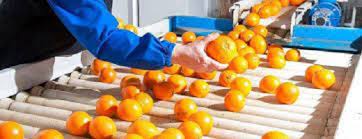
For fresh fruit, standard packing line operations include dumping, culling, washing, brushing, waxing, drying, grading, sizing, and boxing. For processed fruit, growers are compensated based on juice analysis, focusing on sugar content. Harvested fruit is washed before juicing, and juice is extracted by compressing the fruit. The juice, containing pulp and oils, is separated through centrifugation and screening, pooled, and standardized into products with consistent color and sugar levels.
Storage of Citrus
Citrus fruits can be stored at low temperatures (32-40°F) for 1-2 months. Chilling injury is a concern for grapefruit, lemons, and limes when stored below 50°F, but oranges and tangerines are more tolerant of lower temperatures. Citrus fruits can also remain on the tree for extended periods after reaching maturity without softening or abscising, allowing for flexible harvest timing.
Uses of Citrus
1. Oranges and Orange Juice: Approximately one-third of global citrus production is processed, with over 80% of it going toward orange juice production. Florida in the United States and São Paulo in Brazil dominate the orange juice market, producing around 85% of the world’s supply. Brazil exports 99% of its production, while Florida’s production is mostly consumed domestically.
2. Culinary Uses: Citrus fruits such as oranges, tangerines, grapefruits, and clementines are typically consumed fresh, while lemons and limes are used in beverages, garnishes, and cooked dishes. Citrus zest is used as a spice, and citrus juices are widely used in mixed drinks and culinary preparations.
3. Medical Uses: Citrus juice, particularly lemon juice, is used for medicinal purposes, such as treating bee stings. Citrus is also a rich source of vitamin C, which prevents scurvy.
4. Health Benefits and Traditional Usage: Citrus fruits provide various health benefits, including the presence of compounds like D-limonene, which has anti-cancer properties, and carotenoids, which promote cardiovascular health. Citrus is also used traditionally in various cultures for medicinal purposes, including treating digestive issues and regulating fertility. Some citrus plants, such as the curry leaf tree (Murraya koenigii), have culinary and medicinal uses beyond the fruit itself.
Citrus, belonging to the Rutaceae family, is a genus of flowering plants native to tropical and subtropical regions of Southeast Asia. Citrus plants are small trees or large shrubs, known for their evergreen leaves, fragrant flowers, and distinctive fruits. The fruit, called a hesperidium, has a leathery rind and juicy segments, making citrus a highly versatile crop with both commercial and ornamental value.
Throughout this article, the history, origin, and botanical characteristics of citrus were discussed, along with agroclimatic and edaphic requirements for citrus cultivation. The various nursery and field operations involved in citrus production, as well as harvesting and postharvest handling, were explored in detail. Finally, the processing, storage, trade, and diverse uses of citrus and its by-products were also covered.
Do you have any questions, suggestions, or contributions? If so, please feel free to use the comment box below to share your thoughts. We also encourage you to kindly share this information with others who might benefit from it. Since we can’t reach everyone at once, we truly appreciate your help in spreading the word. Thank you so much for your support and for sharing!
Read Also: Complete Composting Guide for Beginners
Frequently Asked Questions
We will update this section soon.
